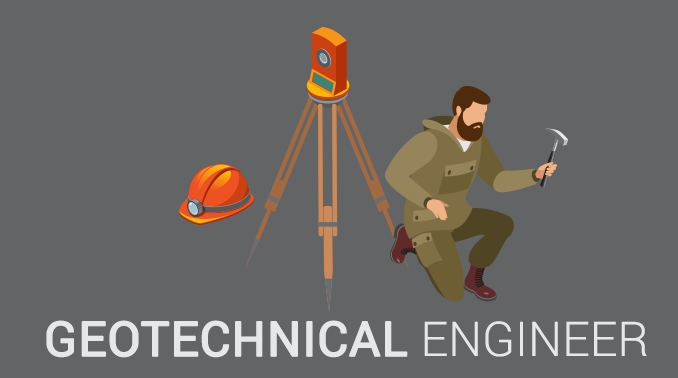The Ultimate Guide To Geotheta
The Ultimate Guide To Geotheta
Blog Article
Fascination About Geotheta
Table of ContentsNot known Factual Statements About Geotheta See This Report on GeothetaThe Best Strategy To Use For GeothetaA Biased View of GeothetaAll About Geotheta

They conduct website investigations, accumulate samples, carry out research laboratory examinations, and assess information to examine the suitability of the ground for building projects - Tailings Engineer. Based upon their searchings for, geotechnical designers provide referrals for structure design, incline security, preserving frameworks, and reduction of geotechnical dangers. They collaborate with various other experts, such as engineers, structural engineers, and building teams, to guarantee that geotechnical factors to consider are integrated right into the total task design and application
By examining the habits and homes of dirt and rock, they can identify potential geotechnical risks such as landslides, soil settlement, or slope instability. Their know-how helps stop failures or accidents that might threaten lives and residential property. Below are some detailed responsibilities and responsibilities of a geotechnical engineer: Site Investigation: Geotechnical designers conduct site investigations to collect data on subsurface conditions.
They analyze the information to understand the residential properties and habits of the soil and rock, including their strength, leaks in the structure, compaction qualities, and groundwater conditions. Geotechnical Evaluation and Layout: Geotechnical engineers examine the data gathered throughout site investigations to examine the security and viability of the site for construction projects. They do geotechnical computations and modeling to review variables such as birthing capability, negotiation, slope stability, lateral planet stress, and groundwater circulation.
The Buzz on Geotheta
Structure Style: Geotechnical designers play an important duty in making structures that can securely support the intended structure. They evaluate the dirt conditions and load demands to establish the proper foundation type, such as shallow foundations (e.g., footings), deep structures (e.g (https://disqus.com/by/geotheta/about/)., heaps), or specialized methods like dirt enhancement. They take into consideration factors such as settlement restrictions, birthing capacity, and soil-structure interaction to create ideal foundation layouts
They review construction plans, display website activities, and carry out field evaluations to validate that the layout recommendations are complied with. If unanticipated geotechnical issues occur, they examine the situation and provide suggestions for remediation or adjustments to the style. Threat Evaluation and Mitigation: Geotechnical engineers analyze geotechnical dangers and risks linked with the job site, such as landslides, liquefaction, or dirt disintegration.

Collaboration and Communication: Geotechnical engineers work closely with various other specialists associated with a task, such as designers, architectural designers, and building teams. Efficient interaction and collaboration are necessary to integrate geotechnical factors to consider right into the general project style and construction procedure. Geotechnical engineers offer technological expertise, response questions, and make sure that geotechnical requirements are satisfied.
The Best Strategy To Use For Geotheta
Below are some sorts of geotechnical engineers: Structure Designer: Structure designers concentrate on designing and assessing structures for frameworks. They examine the dirt conditions, lots needs, and website characteristics to identify the most suitable foundation type and style, such as shallow foundations, deep foundations, or specialized methods like pile foundations.
They review the factors affecting incline security, such as soil properties, groundwater conditions, and slope geometry, and establish approaches to avoid incline failings and reduce dangers. Quake Designer: Quake designers focus on examining and developing structures to stand up to seismic forces. They assess the seismic hazard of a site, evaluate dirt liquefaction capacity, and create seismic layout standards to make sure the security and resilience imp source of structures throughout quakes.
They do field screening, gather samples, and assess the accumulated data to identify the soil properties, geologic developments, and groundwater problems at a website. Geotechnical Instrumentation Designer: Geotechnical instrumentation designers focus on tracking and measuring the actions of dirt, rock, and structures. They mount and preserve instrumentation systems that monitor variables such as dirt settlement, groundwater degrees, incline motions, and structural variations to assess efficiency and provide very early warnings of possible issues.
Fascination About Geotheta
They perform tests such as triaxial tests, consolidation examinations, straight shear tests, and permeability examinations to collect information for geotechnical analysis and layout. Geosynthetics Designer: Geosynthetics engineers concentrate on the layout and application of geosynthetic products, such as geotextiles, geogrids, and geomembranes. They use these products to improve soil stability, reinforce inclines, supply drain options, and control erosion.
They have a tendency to be investigative individuals, which indicates they're intellectual, introspective, and analytical. They are interested, methodical, logical, logical, and sensible. Some of them are also social, indicating they're kind, charitable, participating, individual, caring, useful, understanding, skillful, and pleasant - Consulting Engineers.
In the workplace environment, geotechnical engineers make use of specialized software tools to carry out calculations, create layouts, and evaluate data. They prepare records, testimonial job specifications, communicate with customers and staff member, and coordinate task activities. The workplace setting provides a helpful atmosphere for study, evaluation, and cooperation with various other experts associated with the job.
The Definitive Guide for Geotheta
They often see project sites to conduct site investigations, evaluate geotechnical problems, and collect data for evaluation. These gos to entail traveling to different places, sometimes in remote or challenging terrains. Geotechnical engineers may carry out soil sampling, conduct tests, and display building and construction tasks to make sure that the geotechnical elements of the task are being carried out correctly.
Geotechnical engineers likewise work in specialized geotechnical research laboratories. In these centers, they conduct experiments, execute examinations on soil and rock examples, and analyze the engineering residential properties of the products. Geotechnical research laboratory engineers function extensively in these environments, dealing with testing tools, running tools, and taping data. They work together with various other lab staff to make certain exact and reliable testing results.
Report this page